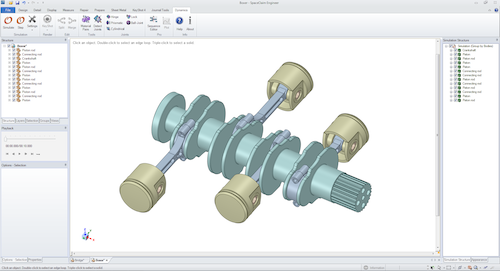Latest News
December 19, 2013
Once the CAD industry’s newcomer, SpaceClaim has just taken the wraps off its 11th release, filling in gaps in the areas of 3D modeling and collaboration while retaining the signature ease of use and flexibility that position SpaceClaim as a 3D CAD offering for non-CAD jockeys.
“We’ve always seen ourselves as a 3D CAD tool for the other 90%,” said Justin Hendrickson, SpaceClaim’s director of product marketing. “One to 2 million people describe themselves as CAD experts or designers and do the detailed design work, but in reality, there are nine times more people that want to use CAD, but can’t because it’s difficult to use.”
Hendrickson says SpaceClaim is not a direct replacement for the parametric or history-based 3D CAD that dominates the heavy lifting of digital design. However, he says it does lend itself to use by those in the engineering process that need access to 3D geometric data in an easier fashion for doing everything from upfront concept modeling to CAE and simulation work.
In the new SpaceClaim Engineer 2014, the company has honed the tool across the board, from fine-tuning the inner workings to boost performance, to new modeling and collaboration capabilities, along with the incorporation of a new module for advanced simulation in the area of dynamics.
On the performance front, SpaceClaim Engineer 2014 has been optimized to better support multithreading, particularly in the area of file import. This results in faster operation for many functions, including a 30% boost in model load times, Hendrickson said. “This is important because users have other job functions more important than dealing with geometry,” he explained.
SpaceClaim 2014 adds a number of other features in the area of faster performance and enhanced productivity. The upgrade supports direct drag and drop file access from Microsoft Outlook along with new semi-parametric functionality and live interference detection.
Another big area of focus for the new release is leveraging the tool for pre-processing for manufacturing and simulation. For example, there are additional interoperability functions aimed at simplifying working with multi-CAD file formats, including new translators and file format capabilities such as Solid Edge AMF and AutoCAD. There is also enhanced PMI support via more use of intelligent capabilities and numerous additional model preparation tools—among them, one that helps position parts more simply along with an unroll function for flattening developable surfaces.
Aside from the new features across all aspects of the tool, SpaceClaim Engineer 2014 adds one new module in the area of simulation. A new fully integrated add-in from Algoryx Simulation is now part of the system, providing motion dynamics for multi-body systems with joints and frictional contacts. When installed, users can click on the Dynamics tab within SpaceClaim to do mechanics modeling, interactive dynamics simulations, plotting and analysis, and full Luxion Keyshot integration for photorealistic simulation videos. The idea of the tool is to bring 3D models to life with physics-based motion dynamics, Hendrickson said.
Watch this video to find out more about Algoryx Simulation.
This video covers the highlights of the SpaceClaim Engineer 2014 release.
Subscribe to our FREE magazine, FREE email newsletters or both!
Latest News
About the Author
Beth Stackpole is a contributing editor to Digital Engineering. Send e-mail about this article to [email protected].
Follow DE






